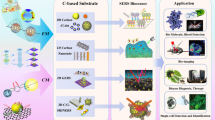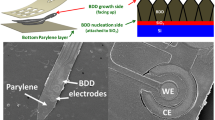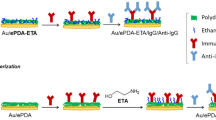Abstract
Diamond exhibits several special properties, for example good biocompatibility and a large electrochemical potential window, that make it particularly suitable for biofunctionalization and biosensing. Here we show that proteins can be attached covalently to nanocrystalline diamond thin films. Moreover, we show that, although the biomolecules are immobilized at the surface, they are still fully functional and active. Hydrogen-terminated nanocrystalline diamond films were modified by using a photochemical process to generate a surface layer of amino groups, to which proteins were covalently attached. We used green fluorescent protein to reveal the successful coupling directly. After functionalization of nanocrystalline diamond electrodes with the enzyme catalase, a direct electron transfer between the enzyme's redox centre and the diamond electrode was detected. Moreover, the modified electrode was found to be sensitive to hydrogen peroxide. Because of its dual role as a substrate for biofunctionalization and as an electrode, nanocrystalline diamond is a very promising candidate for future biosensor applications.
This is a preview of subscription content, access via your institution
Access options
Subscribe to this journal
Receive 12 print issues and online access
$259.00 per year
only $21.58 per issue
Buy this article
- Purchase on Springer Link
- Instant access to full article PDF
Prices may be subject to local taxes which are calculated during checkout






Similar content being viewed by others
References
Collings, A.F. & Caruso, F. Biosensors: recent advances. Rep. Prog. Phys. 60, 1397–1445 (1997).
Bergveld, P. Development of an ion-sensitive solid-state device for neurophysiological measurements. IEEE Trans. Biomed. Eng. BME 17, 70–72 (1970).
Linford, M.R., Fenter, P., Eisenberger, P.M. & Chidsey, C.E.D. Alkyl monolayers on silicon prepared from 1-alkenes and hydrogenated silicon. J. Am. Chem. Soc. 117, 3145–3155 (1995).
Cai, W. et al. Chemical modification and patterning of iodine-terminated silicon surfaces using visible light. J. Phys. Chem. B 106, 2656–2664 (2002).
Lin, Z. et al. DNA attachment and hybridization at the silicon (100) surface. Langmuir 18, 788–796 (2002).
Bakowicz, K. & Mitura, S. Biocompatibility of NCD. J. Wide Bandgap Mater. 9, 261–272 (2002).
Miller, J.B. & Brown, D.W. Photochemical modification of diamond films. Langmuir 12, 5809–5817 (1996).
Ando, T. et al. Diffuse reflectance infrared Fourier-transform study of the direct thermal fluorination of diamond powder surfaces. J. Chem. Soc. Faraday Trans. 91, 3209–3212 (1995).
Ohtani, B. et al. Surface functionalization of doped CVD diamond via covalent bond. An XPS study on the formation of surface-bound quaternary pyridinium salt. Chem. Lett. 27, 953–954 (1998).
Gruen, D.M. Nanocrystalline diamond films. Annu. Rev. Mater. Sci. 29, 211–259 (1999).
Teukam, Z. et al. Shallow donors with high n-type electrical conductivity in homoepitaxial deuterated boron-doped diamond layers. Nature Mater. 2, 482–486 (2003).
Koizumi, S., Watanabe, K., Hasegawa, M. & Kanda, H. Ultraviolet emission from a diamond pn junction. Science 292, 1899–1901 (2001).
Hupert, M. et al. Conductive diamond thin-films in electrochemistry. Diamond Rel. Mater. 12, 1940–1949 (2003).
Strother, T. et al. Photochemical functionalization of diamond films. Langmuir 18, 968–971 (2002).
Yang, W. et al. DNA-modified nanocrystalline diamond thin-films as stable, biologically active substrates. Nature Mater. 1, 253–257 (2002).
Pleskov, Y.U., Sakharova, A.Y., Krotova, M.D., Bouilov, L.L. & Spitsyn, B.V. Photoelectrochemical properties of semiconductor diamond. J. Electroanal. Chem. 228, 19–27 (1987).
Landstrass, M.I. & Ravi, K.V. Resistivity of chemical vapor deposited diamond films. Appl. Phys. Lett. 55, 975–977 (1989).
Maier, F., Riedel, M., Mantel, B., Ristein. J. & Ley, L. Origin of surface conductivity in diamond. Phys. Rev. Lett. 85, 3472–3475 (2000).
Garrido, J.A., Nebel, C.E. & Stutzmann, M. Capacitance–voltage studies of Al-Schottky contacts on hydrogen-terminated diamond. Appl. Phys. Lett. 81, 637–639 (2002).
Birrell, J. et al. Bonding structure in nitrogen doped ultrananocrystalline diamond. J. Appl. Phys. 93, 5606–5612 (2003).
Rezek, B. et al. Fermi level on hydrogen terminated diamond surfaces. Appl. Phys. Lett. 82, 2266–2268 (2003).
Chalfie, M., Tu, Y., Euskirchen, G., Ward, W.W. & Prasher, D.C. Green fluorescent protein as a marker for gene-expression. Science 263, 802–805 (1994).
Armstrong, F.A. & Wilson, G.S. Recent developments in faradaic bioelectrochemistry. Electrochim. Acta 45, 2623–2645 (2000).
Lai, M.E. & Bergel, A. Direct electrochemistry of catalase on glassy carbon electrodes. Bioelectrochemistry 55, 157–160 (2002).
Zhang, Z., Chouchane, S., Magliozzo, R.S. & Rusling, J.F. Direct voltammetry and catalysis with mycobacterium tuberculosis catalase-peroxidase, peroxidases, and catalase in lipid films. Anal. Chem. 74, 163–170 (2002).
Switala, J. & Loewen, P.C. Diversity of properties among catalases. Arch. Biochem. Biophys. 401, 145–154 (2002).
Schoenfisch, M.H. & Pemberton, J.E. Air stability of alkanethiol self-assembled monolayers on silver and gold surfaces. J. Am. Chem. Soc. 120, 4502–4513 (1998).
Acknowledgements
We thank M. Haselbeck for providing the green fluorescent protein, and E. Bertel and N. Memmel for discussions on the properties of nanocrystalline diamond, as well as the Raman spectra shown as supplementary information. We also thank the staff of BESSY for help during the experiments. A.H. acknowledges the Technische Universität München for financial support within a PhD fellowship. J.H. thanks the Alexander von Humboldt Foundation for financial support.
Author information
Authors and Affiliations
Corresponding author
Ethics declarations
Competing interests
The authors declare no competing financial interests.
Supplementary information
Rights and permissions
About this article
Cite this article
Härtl, A., Schmich, E., Garrido, J. et al. Protein-modified nanocrystalline diamond thin films for biosensor applications. Nature Mater 3, 736–742 (2004). https://doi.org/10.1038/nmat1204
Received:
Accepted:
Published:
Issue Date:
DOI: https://doi.org/10.1038/nmat1204
This article is cited by
-
2D MOF-enhanced SPR detector based on tunable supramolecular probes for direct and sensitive detection of DOX in serum
Microchimica Acta (2024)
-
Progress and prospect of diamond dynamic friction polishing technology
The International Journal of Advanced Manufacturing Technology (2023)
-
Multifunctional nanodiamonds as emerging platforms for cancer treatment, and targeted delivery of genetic factors and protein medications—a review
Journal of Materials Science (2022)
-
Structural, photovoltaic and optoelectronic properties of graphene–amorphous carbon nanocomposite
Journal of Materials Science: Materials in Electronics (2021)
-
A simple procedure to obtain nanodiamonds from leftover of HFCVD system for biological application
SN Applied Sciences (2020)



